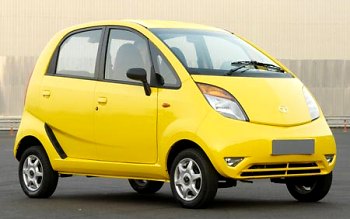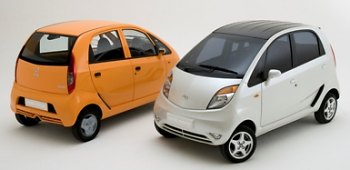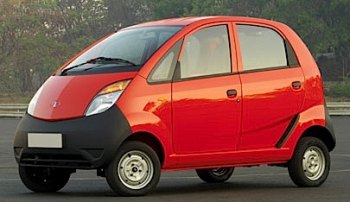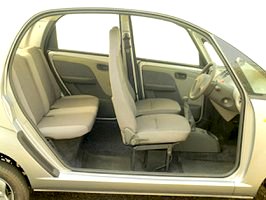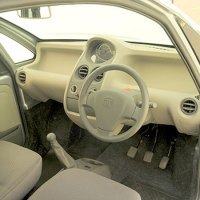Tata Nano
Debut: 2008 |
|||||||||
Tata group is one of those superpowerful conglomerates in Asia that is virtually unknown to the West, at least until it purchased Jaguar Land Rover last year. Established in 1868 by Jamshetji Tata, it was gradually developed into the largest private company in India. Today its business covers nearly all important sectors of India, from steel, electricity and chemicals to IT, finance, hotels and tea. In the field of automobile manufacturing, Tata Motors is already one of the largest bus and truck makers in the world, so why does it bother to build the world's cheapest car? Yes, Nano is by far the cheapest car in the world. In India, its pre-tax price starts from just 100,000 Rupees – equivalent to US$2100, €1500 or £1,300 at the current exchange rate. That is half the price of Maruti 800, the next cheapest car in India, or one-fourth of the cheapest car available in Western Europe. Its profit margin is as thin as its name suggested. Analysts said it will take at least four or five years to break even, and that is unlikely before its production ramp up to half a million units a year. In fact, Nano is created out of the dream of Ratan Tata, chairman of the group and the great grandson of its founder. Seeing himself as the Henry Ford of India, Ratan Tata wants to produce a car really affordable by his people and eventually put the whole Indian society on wheels. Even though the country is one of the members of BRIC, the majority of its people are still too poor to afford a 4-wheel car. Everyday tenths of million of Indian travel from home to workplace by poorly-built scooters and motorbikes. Many of these 2-wheelers are overloaded with a whole family and their belongings, which is hardly a safe and comfortable way to transport. Their low emission standards and poor maintenance also cause a lot of pollution. What Ratan Tata wants is to build a sturdy, safe and modern car to replace these 2-wheelers.
Yes, the Nano does look modern. Its cult, monospace appearance was designed by Italian design house IDEA which also did Tata Indica and many Fiat models in the past. It looks like a slightly longer and rounder version of Smart Fortwo. In terms of size, it slots between the Smart and a Japanese K-car thanks to a 3.1m length and 1.5m width. At 600-635 kg depending on specifications, the Nano is lighter than a base Smart by over 100 kilograms even though it is a 4-seater. Well, this is hardly surprising considering its lower standards of safety, comfort and emission compared to the those of developed countries. Anyway, the lightweight means it needs to be powered by no more than a 624cc twin-cylinder engine, with the simplest SOHC 2-valve head and 35 horsepower output. A 65 mpg top speed would be a nightmare to European motorists, but it is considered perfectly adequate on Indian roads. The Indian People's Car has a lot of commonalities with the original Volkswagen Beetle or Fiat 500 not only in their vision, but also in mechanical layout - all of them are rear-engined. From the outset, rear-engined layout was chosen by Tata in order to save cost. By shifting the engine from the nose to the tail, Nano has a weight distribution of 42:58. The lighter load at the front wheels means it doesn't need to employ power steering (the skinny, 135/70R12 front tires also help). Moreover, the space freed up at the front end enables the Nano to pass crash protection regulations more easily, reducing both metal and engineering works. Besides, it allows the Nano to employ a cab-forward profile to enhance interior space. This explains why it could accommodate 4 adults in such a short length. Unlike conventional monocoque structure, the Nano is made in two parts. The whole powertrain (engine, transmission and axle) and semi-trailing arm rear suspensions are carried on a separate subframe, which is then welded to the steel monocoque bodyshell. This design allows the subframe part and bodyshell to be built at two separate satellite plants. In the future, Tata could produce them in kits and outsource the final assembly once the 500,000 units capacity of its main assembly plant is exceeded.
Although the Nano looks like a hatchback, it is not. It has neither a tailgate nor a boot lid because Tata wants to minimize costs as far as possible. Saving a couple of hinges won't save a lot of money, but the lack of a large opening at the back means it can achieve the required body strength with the least amount of metal, which is most tempting to Tata. As a result, access to the tiny boot can only be made through the rear doors with the rear seat folded. Tata and its Western consultants really worked very hard to achieve the target base price of 100,000 Rupees. For example, the Bosch engine management system dubbed "Value Motronic" has some sensors eliminated. The wheels are small at 12-inch diameter, and only 3 bolts are used to fix each of them to the suspension. The suspension goes without any anti-roll bars. All brakes are unservoed drums and no ABS is offered. The windscreen has only 1 wiper. The passenger side mirror is discarded because it is thought to be unessential. Ditto the rev counter. Even the battery is placed under the front seat instead of the nose in order to shorten the cable. Tata did whatever we could not imagine to save money. Open the doors, the cheapness is obvious. The whole dashboard is made of a single piece of plastic molding. Equipment is spartan - no glovebox, no audio, no airbags... Air-conditioning and power windows are only offered on more luxury models. The whole cabin is hardly trimmed, with exposed metal everywhere, including the ugly seat brackets. The seats themselves are thin and flat. Only the driver gets limited adjustment, other seats are fixed. All seats are mounted high and upright, so four Indian adults will find surprising amount of legroom for such a small car. The tall-body design also enables generous headroom. Large windows contribute to a light and airy environment.
On the road, the Nano performs better than it has any right to be. The twin-cylinder engine pulls with surprising tractability and smoothness, if not quietness because the cabin has no sound insulation at all. Even with four people on board it can still cruise comfortably at 50 mph on highway. The cable-operated gearshift is generally slick, although the clutch take up is somewhat abrupt. The Nano will return 55 mpg if tested according to European combined cycle. The unassisted steering is quite heavy at parking, but its effort comes down dramatically at speed. Its small turning circle is a bonus to driving in congested city. However, in terms of handling and ride the Nano is no where near a proper small car. The lack of anti-roll bars called for stiff springs which compromise its ride quality yet fail to contain the excessive body roll. The damping also needs sorting out. Riding over a pothole and the car bounces severely. There is a lot of longitudinal pitch due to the heavy tail, especially when the car is fully loaded. The Nano's handling is generally fool proof because the narrower front tires are chosen to induce terminal understeer. At higher speed its handling is less stable. For a car costing so little money, Nano should not be judged according to the standards of conventional cars. See it as a replacement to motorbikes and you will have a completely different conclusion. Undeniably, Ratan Tata's brainchild has already exceeded the expectation of everybody. His brave attempt deserves great success. |
|||||||||
| The above report was last updated on 11 Jul 2009. All Rights Reserved. |
